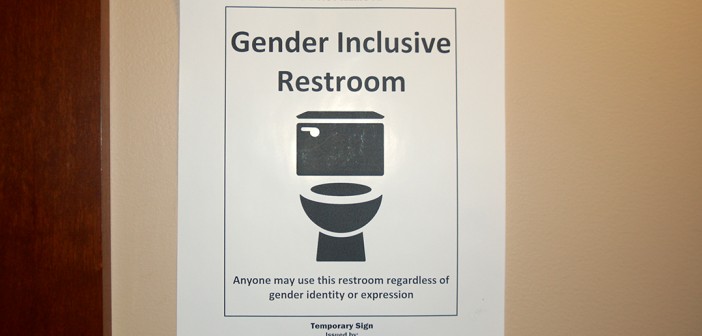In an effort to foster a more gender-inclusive Lehigh community, many restrooms at the university have been converted from gender-specific to gender-inclusive facilities. Initially pitched to the Pride Center for Sexual Orientation and Gender Diversity by Elizabeth Pines, ’16, during the fall semester, numerous gender-inclusive restroom fliers have replaced the former male and female signs on bathroom doors.
According to Trish Boyles, the director of the Pride Center, these gender-inclusive facilities are for all within the Lehigh community regardless of how they self-identify. She said they are more about rebranding the idea of restrooms, rather than physically remodeling the campus facilities.
“Pines brought the proposal for gender-inclusive restrooms to me and found that a lot of other schools were doing it,” Boyles said.
Giving Pines credit for bringing the idea to the Pride Center in hopes of getting assistance proposing it to the administration, Boyles said she was excited to move forward with this initiative. It aligned with the goals of the Pride Center and was cheaper to implement across campus than it would be to remodel the bathrooms.
Boyles, along with deans, faculty and representation from almost all administrative divisions, agreed this reconfiguration of facilities was a great direction for the school.
“The response has been overwhelmingly positive,” Pines said, “and even residential services has gotten excited about the gender-inclusive restrooms.”
Pines said that because it has been a slow process, the buzz around campus has only made it a more anticipated project and has been widely supported.
“It’s a no-brainer,” Pines said. “Everyone deserves a safe place to use public facilities. Why not if we can make Lehigh more inclusive of the transgender community in the process?”
Boyles said the rebranding is an easy change that can have a big impact.
“(Gender-inclusivity) starts the conversation about transgender and gender identity and gives a platform for broader efforts across campus,” Boyles said.
Boyles made a point to emphasize the use of the word “inclusive” rather than “neutral” to better represent the goals of these renovations. There are some individuals who may not necessarily identify with the male or female restroom signs, and the word “inclusive” is to help encourage those people, and everyone else, to feel they have accessible and approachable facilities.
Andrew Kuroki, ’16, thought the effort to be somewhat unnecessary but backed with good intention.
“I see that it might convenience people, but it’s not that crazy of a concept,” Kuroki said.
Linking his theory with the unisex restrooms that have been around campus for years already, Kuroki said he believes it is the concept of labels that have become the issue rather than comfort.
“At my house, there’s not a male and female restroom,” Kuroki said. “A bathroom is a bathroom.”
Kuroki also mentioned the many upsides to implementing these gender-inclusive restrooms, such as private bathroom time and the fact that it is an economically efficient way of making an impact on the campus community dynamic of acceptance. Kuroki thinks this is not a revolutionary idea, but it is necessary within a community that is trying to be as accepting and as politically sensitive as possible.
“Honestly, I prefer the individual bathrooms,” he said. “It’s nice to have your alone time in (the restroom) and you get used to it at home, so why should it be the complete opposite if you are away at college?”
While students have noticed the signs’ impacts on restroom use across campus, Boyles says there is still work to be done in the process of making Lehigh a completely gender-inclusive place.
“There are two phases to the project: implementing gender-inclusive restrooms and increasing the number of gender-inclusive bathrooms,” Boyles said. “We are in the final stages of this first phase.”
The second phase is aligned to start next semester, but the final step to complete the first phase is to get real restroom plaques rather than the pieces of paper that are currently still hanging.
Boyles pointed out that this is an issue with the manufacturers and the official signs should be coming in soon. She is still optimistic that the direction these efforts are steering the community in a more inclusive direction.






Comment policy
Comments posted to The Brown and White website are reviewed by a moderator before being approved. Incendiary speech or harassing language, including comments targeted at individuals, may be deemed unacceptable and not published. Spam and other soliciting will also be declined.
The Brown and White also reserves the right to not publish entirely anonymous comments.